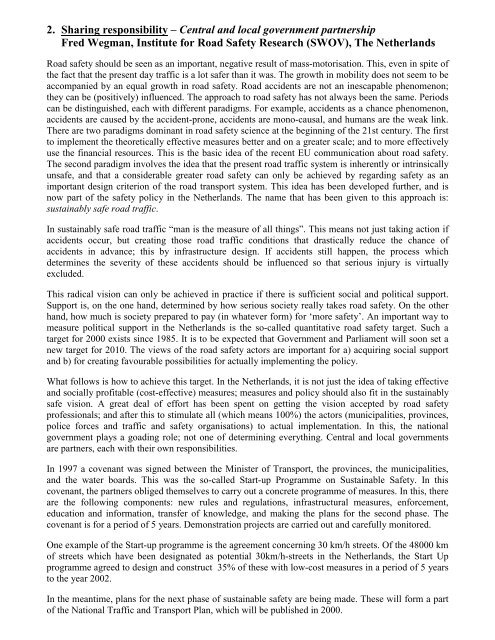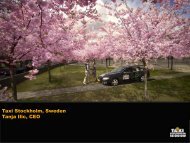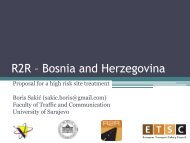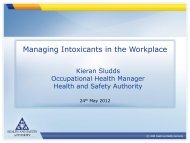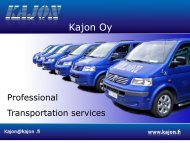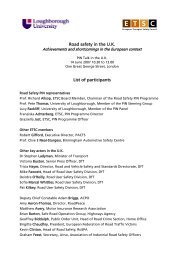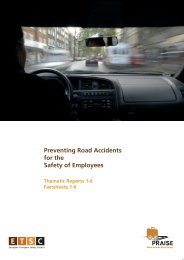BEST IN EUROPE ROAD SAFETY CONFERENCE - ETSC
BEST IN EUROPE ROAD SAFETY CONFERENCE - ETSC
BEST IN EUROPE ROAD SAFETY CONFERENCE - ETSC
Create successful ePaper yourself
Turn your PDF publications into a flip-book with our unique Google optimized e-Paper software.
2. Sharing responsibility – Central and local government partnership<br />
Fred Wegman, Institute for Road Safety Research (SWOV), The Netherlands<br />
Road safety should be seen as an important, negative result of mass-motorisation. This, even in spite of<br />
the fact that the present day traffic is a lot safer than it was. The growth in mobility does not seem to be<br />
accompanied by an equal growth in road safety. Road accidents are not an inescapable phenomenon;<br />
they can be (positively) influenced. The approach to road safety has not always been the same. Periods<br />
can be distinguished, each with different paradigms. For example, accidents as a chance phenomenon,<br />
accidents are caused by the accident-prone, accidents are mono-causal, and humans are the weak link.<br />
There are two paradigms dominant in road safety science at the beginning of the 21st century. The first<br />
to implement the theoretically effective measures better and on a greater scale; and to more effectively<br />
use the financial resources. This is the basic idea of the recent EU communication about road safety.<br />
The second paradigm involves the idea that the present road traffic system is inherently or intrinsically<br />
unsafe, and that a considerable greater road safety can only be achieved by regarding safety as an<br />
important design criterion of the road transport system. This idea has been developed further, and is<br />
now part of the safety policy in the Netherlands. The name that has been given to this approach is:<br />
sustainably safe road traffic.<br />
In sustainably safe road traffic “man is the measure of all things”. This means not just taking action if<br />
accidents occur, but creating those road traffic conditions that drastically reduce the chance of<br />
accidents in advance; this by infrastructure design. If accidents still happen, the process which<br />
determines the severity of these accidents should be influenced so that serious injury is virtually<br />
excluded.<br />
This radical vision can only be achieved in practice if there is sufficient social and political support.<br />
Support is, on the one hand, determined by how serious society really takes road safety. On the other<br />
hand, how much is society prepared to pay (in whatever form) for ‘more safety’. An important way to<br />
measure political support in the Netherlands is the so-called quantitative road safety target. Such a<br />
target for 2000 exists since 1985. It is to be expected that Government and Parliament will soon set a<br />
new target for 2010. The views of the road safety actors are important for a) acquiring social support<br />
and b) for creating favourable possibilities for actually implementing the policy.<br />
What follows is how to achieve this target. In the Netherlands, it is not just the idea of taking effective<br />
and socially profitable (cost-effective) measures; measures and policy should also fit in the sustainably<br />
safe vision. A great deal of effort has been spent on getting the vision accepted by road safety<br />
professionals; and after this to stimulate all (which means 100%) the actors (municipalities, provinces,<br />
police forces and traffic and safety organisations) to actual implementation. In this, the national<br />
government plays a goading role; not one of determining everything. Central and local governments<br />
are partners, each with their own responsibilities.<br />
In 1997 a covenant was signed between the Minister of Transport, the provinces, the municipalities,<br />
and the water boards. This was the so-called Start-up Programme on Sustainable Safety. In this<br />
covenant, the partners obliged themselves to carry out a concrete programme of measures. In this, there<br />
are the following components: new rules and regulations, infrastructural measures, enforcement,<br />
education and information, transfer of knowledge, and making the plans for the second phase. The<br />
covenant is for a period of 5 years. Demonstration projects are carried out and carefully monitored.<br />
One example of the Start-up programme is the agreement concerning 30 km/h streets. Of the 48000 km<br />
of streets which have been designated as potential 30km/h-streets in the Netherlands, the Start Up<br />
programme agreed to design and construct 35% of these with low-cost measures in a period of 5 years<br />
to the year 2002.<br />
In the meantime, plans for the next phase of sustainable safety are being made. These will form a part<br />
of the National Traffic and Transport Plan, which will be published in 2000.


